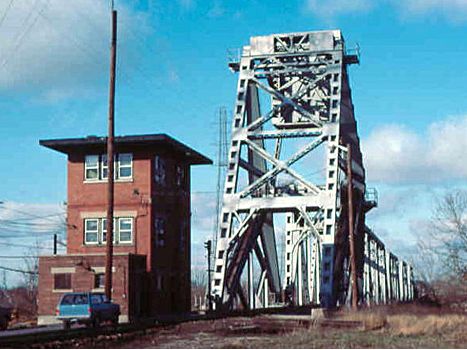- Details
- Hits: 179
Location: Saginaw, MI - Washington Street Tower (PM-C&O)
 The Washington Street tower was located on the east side of the PM/C&O drawbridge over the Saginaw River. The tower was 3-story and of brick construction.
The Washington Street tower was located on the east side of the PM/C&O drawbridge over the Saginaw River. The tower was 3-story and of brick construction.
Image Info: Top, the CSX Saginaw River drawbridge just west of the Potter Street Station in Saginaw in 1983. The river is now closed to large ships at this location and the bridge is locked in the closed position. [Ron Hagemeister].
Notes
Washington Street tower had the controls for the Saginaw River drawbridge and also controlled movements entering and leaving the west end of Saginaw Yard. Besides controlling the derails and signals for the bridge, they controlled signals from both the Ludington main line and the Bay City branch going northeast. Using a small desktop GRS CTC machine, they also controlled the signals coming off leads out of the yard (westward).
The tower had 3 stories. The ground level contained the heating boiler and electrical apparatus for the bridge. The operator was located on the second level. The West End dispatcher (who controlled the Ludington Sub and Elmdale, Bad Axe and Port Huron subs) was on the top level with access by one of those winding stairways. I worked both the operator's job and dispatcher off the extra board from 1976-1981. In '81, I got the 2nd trick dispatching job, working from this tower.
In 1984, the Ludington CTC machine was moved across the street to the freight house where the chief dispatcher and south end dispatchers were housed. I worked from there until 1988. I also worked as the south end dispatcher and as assistant chief dispatcher.
The operator at Washington Avenue (telegraph call WS) copied lots of train orders for both westward trains and trains leaving south or east out of the yard. They also faxed orders and clearances to the four southbound trains that originated at McGrew. The operators worked with both dispatchers and the Saginaw yardmasters. The clerks working in Saginaw, McGrew (Flint) and Grand Blanc also called in information to be relayed to the dispatchers. Washington Street was a busy tower. The best operators would try to anticipate the information that the dispatchers would need and supply it before the dispatcher had to ask. [DH]
Time Line
1889. The F&PM have recently erected a signal tower in their yard at North Washington avenue, and introduced what is known as the Union Switch and Signal system, whose advantages over the old style are very apparent to the most casual observer. There is an interlocking apparatus fixed in the tower which contracts the switches, works the signals, also bolt-locks both drawbridges so that they are absolutely safe for a train going in an east direction, the drawbridges being controlled by a man in the tower. There are detector bars forty feet in length, so that when a train passing over a switch the operator in the tower cannot make a mistake while a train is passing over, as he has left this bar in position, rendering it impossible to split the train.
The old target system does not begin to compare with the new one, having no interlocking line target set and switches which are dependent entirely upon a man on the ground. [SAG-1889-1011]
1984. The Ludington CTC machine is moved from the 3rd floor of this tower to the freight house on the east side of Washington Ave., joining the other Saginaw dispatcher at that location. [DH]
Bibliography
The following sources are utilized in this website. [SOURCE-YEAR-MMDD-PG]:
- [AAB| = All Aboard!, by Willis Dunbar, Eerdmans Publishing, Grand Rapids ©1969.
- [AAN] = Alpena Argus newspaper.
- [AARQJ] = American Association of Railroads Quiz Jr. pamphlet. © 1956
- [AATHA] = Ann Arbor Railroad Technical and Historical Association newsletter "The Double A"
- [AB] = Information provided at Michigan History Conference from Andrew Bailey, Port Huron, MI

